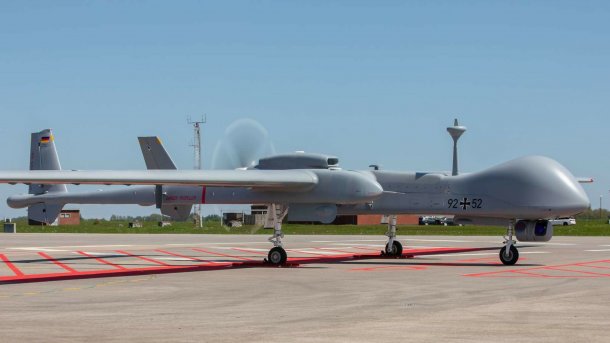Heron TP drone: Development overslept for a long time
The Bundeswehr's new Heron TP drones are long overdue. The development was overslept, says an expert from the IISS think tank.

One of the Bundeswehr's new Heron TP drones.
(Image: Bundeswehr / Cora Mohrdieck)
In view of the extensive use of drones in the Russian war of aggression against Ukraine, expert Fabian Hinz from the IISS think tank in Berlin believes that the German armed forces and their partners still have a lot of catching up to do. "Very few armies in the world are equipped for such an eventuality," says Hinz. "The Bundeswehr will certainly also have problems, simply because what we are now seeing in Ukraine, the massive use of small, commercially available drones, is a new experience."
Heron as an important first step
Hinz praised the flight operations of the new Heron TP reconnaissance drone, which can be equipped with missiles, as an important step. Until now, the Bundeswehr had only used drones abroad. "Deployment within Germany is associated with certain bureaucratic obstacles, which can be severe," said Hinz. The fact that this has changed is an important milestone. However, there is still a lot of room for improvement.
"In principle, the big challenge is to know what the lessons from Ukraine are," says Hinz. Different systems have been useful in different phases. "The rules for modern drone warfare are only now being written. That's why it's very, very difficult to draw the right lessons from the war and anticipate what will come in a few years' time and what threats we will face."
Oversleeping developments
Hinz criticizes the fact that Germany overslept development for a long time. The design for one of the first so-called suicide drones, the Anti-Radar drone for use against enemy radar positions, was developed by Dornier at the end of the 1980s. However, it never went into production in Germany. "Then the design somehow found its way to Israel. The Israelis then built these drones as the Harpy and developed them further into the Harop." The Iranians, in turn, copied the Harpy, enlarged it and adapted the controls. "This then became the Shahed-136." This drone is also frequently used by Russian troops in Ukraine.
"If Germany had continued down this path back then, it would, of course, be much, much further along now and would actually have very, very powerful weapons that could also be delivered to its partners in Ukraine," says Hinz. No truly operational product has emerged from other research either. "That is the fundamental problem. You have research, you have technological development, you have prototypes in some cases. But there simply wasn't the political will behind it to translate the technology you have into an operational product." The reason for this was the end of the Cold War. Back then, defense was considered a dirty business. "And drones are of course much 'dirtier'".
(bme)